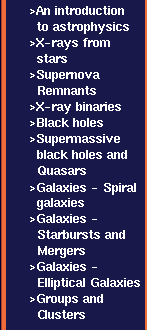


|
GALAXIES - STARBURSTS AND MERGERS What are starburst galaxies?Starbursts are sites of large-scale, extremely high-rate star formation. These systems experience star formation at a rate that can only be maintained in equilibrium if the duration of the star formation activity (perhaps 10 million years) is short compared to the life of the galaxy. Though our understanding of their causes, properties, and evolution is not complete, a large fraction of high-luminosity starbursts are thought to be triggered by interactions between galaxies. It is also believed that the bars within barred spirals may be the cause of some starbursts. Effects such as these cause interstellar gas to be compressed and heated, and converted rapidly into stars. Often this occurs within the galaxy nucleus itself. How do starburst galaxies appear in X-rays? Starbursts tend to have very enhanced X-ray emission compared to more normal galaxies, and their X-ray emission usually originates from spatially extended regions, the largest of which is often at the galaxy nucleus. As these massive stars in the starburst nucleus go supernova, the combined mass of hot supernova gas can blow out of the plane of the galaxy in huge plumes, and can be visible in X-rays extending for perhaps 30,000 light years. Hydrodynamical computer models have been performed to try and mimic these features. |
|
|
![[NGC253]](images/starburst/ngc253_w_s.jpg)
![[Wind
simulation]](images/starburst/wind_big.gif)

